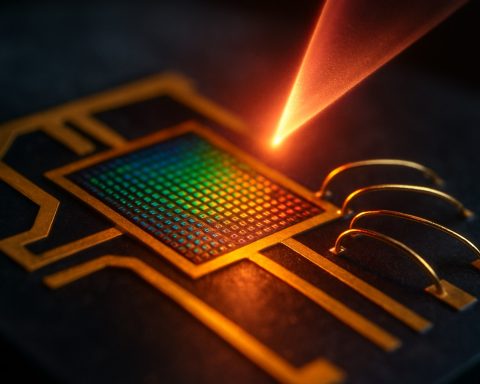- Sharjah Maritime Academy (SMA) is revolutionizing education by incorporating blockchain technology.
- Partnering with Educhain, SMA offers blockchain-based micro-credentials, which are secure, tamper-proof, and globally verifiable.
- This innovation allows students to easily share their certified skills on platforms like LinkedIn, enhancing job market readiness.
- SMA’s approach aligns with a global shift toward skill-focused education that meets the dynamic needs of industries.
- The technology used, Hyperledger Fabric, ensures robust and scalable digital certification processes.
- SMA’s initiative, led by Chancellor Dr. Hashim Al Zaabi, sets a precedent for maritime education and beyond.
- This venture highlights a commitment to modern, adaptable education, setting new standards in the digital age.
Amid the picturesque landscape of Sharjah’s mountain vistas, a quiet revolution is brewing in the realm of education. The Sharjah Maritime Academy (SMA) has boldly embraced the digital frontier by integrating blockchain technology into their educational framework, offering students a new way to validate their skills and achievements.
Imagine holding in your hands a credential that is as solid and unchangeable as a diamond, as trustworthy as the sunrise. Through a strategic partnership with Educhain, a pioneer in blockchain-based solutions, SMA has launched micro-credentials that promise to do just that. These digital certifications are securely recorded on a blockchain, ensuring they are instantly verifiable, immune to tampering, and easily shareable across the globe.
This innovative approach signifies more than just a technological advancement; it represents a seismic shift in education. Traditionally, academic qualifications were static and vulnerable to forgery. Now, SMA’s students can instantly validate their competencies with certificates that employers worldwide can trust. With the click of a button, a student can showcase their certified skills on platforms like LinkedIn, bridging the critical gap between academic accomplishments and professional aspirations.
The digital wave sweeping SMA aligns with the broader trend toward skill-focused education that prepares students for a dynamic job market. The academy’s foresight positions it alongside a burgeoning global movement toward educational methods that prioritize agility and relevance. By opting for micro-credentials, SMA underscores its dedication to crafting an education system that is not only modern but also adaptable, addressing the urgent demands of industries that are constantly in flux.
Educhain’s underlying technology brings robustness to this transformation. It leverages Hyperledger Fabric, a blockchain framework known for its reliability and scalability. This technology is not just a futuristic accessory; it is a tool transforming how qualifications are issued and validated, ultimately redefining the concept of employability in the digital age.
For SMA, led by visionary figures like Chancellor Dr. Hashim Al Zaabi, embracing such technological innovations is part of a broad commitment to redefining maritime education. The academy’s audacious stride into digital credentialing reflects its aspiration to foster future leaders poised for success on the global stage.
In summary, SMA’s venture into blockchain-powered micro-credentials is a beacon to other institutions, illuminating a path toward a future where educational achievements are as functional and mobile as the lives they aim to improve. As we wade deeper into the digital era, the legacy of SMA’s initiative will likely echo far beyond the azure waters of Sharjah, setting new standards for what education can and should be.
How Blockchain is Revolutionizing Education: The Bold Move by Sharjah Maritime Academy
Introduction
Amid Sharjah’s stunning mountain vistas, a quiet yet revolutionary change is reshaping education. The Sharjah Maritime Academy (SMA) is leveraging blockchain technology to offer secure, verifiable micro-credentials in partnership with Educhain. These credentials are set to redefine how educational achievements are perceived and utilized globally.
Blockchain in Education: More Than Just Tech
The SMA Approach
The integration of blockchain technology by SMA is more than a mere tech upgrade; it represents a transformation in credibility. Traditional certificates are susceptible to forgery, but blockchain ensures each credential is as immutable as diamond. Using Hyperledger Fabric, SMA ensures scalability and reliability in its certification processes.
Global Trends and Advantages
1. Instant Verification: Blockchain allows for rapid confirmation of credentials, reducing waiting times for employers and educational institutions.
2. Immunity to Tampering: Credentials are securely recorded on the blockchain, making them immune to unauthorized alterations.
3. Global Accessibility: With such credentials, students can share their achievements seamlessly on platforms like LinkedIn, appealing to a worldwide audience.
Skill-Focused Education for Dynamic Markets
The world is shifting towards skill-based education to better prepare students for a volatile job market. Micro-credentials are becoming essential in this transformation, equipping students with the ability to quickly demonstrate specific competencies. SMA’s initiative aligns it with global educational movements that prioritize agility and relevancy.
How-To Steps: Exploring Blockchain Credentials
1. Understand Blockchain Basics: Begin with a foundational understanding of how blockchain works.
2. Research Institutions like SMA: Look into schools that offer blockchain-based credentials.
3. Engage with Platforms: Use platforms such as LinkedIn to showcase new, verifiable skills.
Real-World Use Cases
– Enhanced Employability: Employers can instantly verify skills, cutting down recruitment time and reducing risk.
– Increased Student Mobility: Students can study globally with universally recognized credentials.
Industry Trends and Market Forecast
The educational sector is moving towards more digital and flexible learning models:
– Projected Growth: The global online education market is expected to grow, with blockchain playing a pivotal role (Source: MarketsandMarkets).
– Increased Investment: More educational institutions are investing in digital credentialing technologies to stay competitive.
Pros and Cons of Blockchain-Based Credentials
– Pros: Secure, verifiable, timeless.
– Cons: Initial implementation costs, requires technical understanding.
Conclusion and Recommendations
SMA’s adoption of blockchain in education paves the way for more trusted and efficient systems of certification globally. Other educational institutions would benefit tremendously from exploring similar partnerships and technologies.
Quick Tips for Students
1. Stay Informed: Remain updated about digital credential trends and technologies.
2. Network: Use micro-credentials to enhance your professional profile on social media platforms.
3. Engage with Innovators: Look for opportunities in institutions embracing cutting-edge educational technologies.
By staying nimble and informed, students and institutions alike can benefit immensely from the shift towards blockchain-powered micro-credentials.
For more insights into blockchain and education, check out IBM and Hyperledger.









